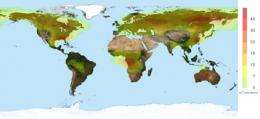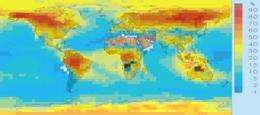New satellite observations reveal link between forests and acid rain

A team from LATMOS/IPSL, working in collaboration with Belgian researchers from the Institut d'Aeronomie Spatiale de Belgique (IASB) and the Universite Libre de Bruxelles (ULB), have revealed the existence of a major source of formic acid from boreal and tropical forests. Formic acid is known to be the main cause of rainfall acidity in these regions. These results, obtained using infrared data from France's IASI instrument on board the MetOp meteorological satellite, are published online in the scientific journal Nature Geoscience dated 18 December 2011.
In the polluted regions of our planet, acid rain is caused by nitric and sulfuric acids. What is not so well known is that formic acid, the simplest of all the organic acids, makes a significant contribution to rainfall acidity in remote, isolated environments. The atmospheric cycle of this compound is only poorly understood: formic acid is directly emitted into the atmosphere by human activity, forest fires, and plant leaves, which contribute to so-called biogenic emissions. Formic acid can also be produced by the photochemical breakdown of other organic compounds also emitted by vegetation. This is both the most important and uncertain source of the compound.
-

Percentage contribution to acid rain in various regions of the world. Credit: IASB -

The MetOp satellite launched at the end of 2006. An arrow points at the IASI instrument. Credit: CNES/Eumetsat
Relying on the first-ever global mapping of formic acid, obtained using infrared data from the MetOp satellite's IASI instrument, the researchers have managed to considerably reduce this uncertainty through numerical simulations carried out with the IMAGES atmospheric chemistry model developed at IASB. The model and the IASI data enabled the researchers to show that, globally, forests produce around 100 million tons of formic acid per year, which is three times more than the sources identified up till now. This new source, which is particularly dense over boreal forests, is in all likelihood caused by the oxidation of organic compounds, mainly emitted by conifers. Although the precise nature of these short-lived compounds remains unknown, it was possible to determine their impact on acid precipitation using global modeling of the atmospheric cycle of formic acid. The researchers show that this additional source of the compound increases rainfall acidity, and they estimate formic acid's contribution to acid rain at 60-80% over the taiga in summer. This can also reach 30-50% in the US over the same period.
More information: Satellite evidence for a large source of formic acid from boreal and tropical forests, T. Stavrakou, et al., Nature Geoscience, on line 18 December 2011.
Journal information: Nature Geoscience
Provided by CNRS



















